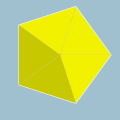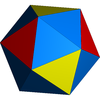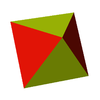Icosahedron
| Regular Icosahedron | |
|---|---|
 (Click here for rotating model) |
|
| Type | Platonic solid |
| Elements | F = 20, E = 30 V = 12 (χ = 2) |
| Faces by sides | 20{3} |
| Schläfli symbol | {3,5} |
| Wythoff symbol | 5 | 2 3 |
| Coxeter-Dynkin | |
| Symmetry | Ih (*532) |
| References | U22, C25, W4 |
| Properties | Regular convex deltahedron |
| Dihedral angle | 138.189685° = arccos(-√5/3) |
 3.3.3.3.3 (Vertex figure) |
 Dodecahedron (dual polyhedron) |
 Net |
|
In geometry, an icosahedron (Greek: εικοσάεδρον, from eikosi twenty + hedron seat; pronounced /ˌaɪkɵsəˈhiːdrən/ or /aɪˌkɒsəˈhiːdrən/; plural: -drons, -dra /-drə/) is a regular polyhedron with 20 identical equilateral triangular faces, 30 edges and 12 vertices. It is one of the five Platonic solids.
It has five triangular faces meeting at each vertex. It can be represented by its vertex figure as 3.3.3.3.3 or 35, and also by Schläfli symbol {3,5}. It is the dual of the dodecahedron, which is represented by {5,3}, having three pentagonal faces around each vertex.
Dimensions
If the edge length of a regular icosahedron is  , the radius of a circumscribed sphere (one that touches the icosahedron at all vertices) is
, the radius of a circumscribed sphere (one that touches the icosahedron at all vertices) is
and the radius of an inscribed sphere (tangent to each of the icosahedron's faces) is
while the midradius, which touches the middle of each edge, is
where  (also called
(also called  ) is the golden ratio.
) is the golden ratio.
Area and volume
The surface area A and the volume V of a regular icosahedron of edge length a are:
Cartesian coordinates

The following Cartesian coordinates define the vertices of an icosahedron with edge-length 2, centered at the origin:
- (0, ±1, ±φ)
- (±1, ±φ, 0)
- (±φ, 0, ±1)
where φ = (1+√5)/2 is the golden ratio (also written τ). Note that these vertices form five sets of three concentric, mutually orthogonal golden rectangles, whose edges form Borromean rings.
If the original icosahedron has edge length 1, its dual dodecahedron has edge length  , one divided by the golden ratio.
, one divided by the golden ratio.
The 12 edges of a regular octahedron can be subdivided in the golden ratio so that the resulting vertices define a regular icosahedron. This is done by first placing vectors along the octahedron's edges such that each face is bounded by a cycle, then similarly subdividing each edge into the golden mean along the direction of its vector. The five octahedra defining any given icosahedron form a regular polyhedral compound, as do the two icosahedra that can be defined in this way from any given octahedron.
Other facts
- It has 143,380 nets.
- To color the icosahedron, such that no two adjacent faces have the same color, requires at least 3 colors.
- When an icosahedron is inscribed in a sphere, it occupies less of the sphere's volume (60.54%) than a dodecahedron inscribed in the same sphere (66.49%).
Construction by a system of equiangular lines
The following construction of the icosahedron avoids tedious computations in the number field ![\mathbb{Q}[\sqrt{5}]](/2010-wikipedia_en_wp1-0.8_orig_2010-12/I/b0ab3184ae61460368133b6d3570cd09.png) necessary in more elementary approaches.
necessary in more elementary approaches.
The existence of the icosahedron amounts to the existence of six equiangular lines in  . Indeed, intersecting such a system of equiangular lines with a Euclidean sphere centered at their common intersection yields the twelve vertices of a regular icosahedron as can easily be checked. Conversely, supposing the existence of a regular icosahedron, lines defined by its six pairs of opposite vertices form an equiangular system.
. Indeed, intersecting such a system of equiangular lines with a Euclidean sphere centered at their common intersection yields the twelve vertices of a regular icosahedron as can easily be checked. Conversely, supposing the existence of a regular icosahedron, lines defined by its six pairs of opposite vertices form an equiangular system.
In order to construct such an equiangular system, we start with this  square matrix:
square matrix:
A straightforward computation yields  (where
(where  is the 6x6 identity matrix). This implies that
is the 6x6 identity matrix). This implies that  has eigenvalues
has eigenvalues  and
and  , both with multiplicity 3 since
, both with multiplicity 3 since  is symmetric and of trace zero.
is symmetric and of trace zero.
The matrix  induces thus an Euclidean structure on the quotient space
induces thus an Euclidean structure on the quotient space  which is isomorphic to
which is isomorphic to  since the kernel
since the kernel  of
of  has dimension 3. The image under the projection
has dimension 3. The image under the projection  of the six coordinate axes
of the six coordinate axes  in
in  forms thus a system of six equiangular lines in
forms thus a system of six equiangular lines in  intersecting pairwise at a common acute angle of
intersecting pairwise at a common acute angle of  . Orthogonal projection of
. Orthogonal projection of  onto the
onto the  -eigenspace of
-eigenspace of  yields thus the twelve vertices of the icosahedron.
yields thus the twelve vertices of the icosahedron.
A second straightforward construction of the icosahedron uses representation theory of the alternating group  acting by direct isometries on the icosahedron.
acting by direct isometries on the icosahedron.
Symmetry
The rotational symmetry group of the regular icosahedron is isomorphic to the alternating group on five letters. This non-abelian simple group is the only non-trivial normal subgroup of the symmetric group on five letters. Since the Galois group of the general quintic equation is isomorphic to the symmetric group on five letters, and this normal subgroup is simple and non-abelian, the general quintic equation does not have a solution in radicals. The proof of the Abel-Ruffini theorem uses this simple fact, and Felix Klein wrote a book that made use of the theory of icosahedral symmetries to derive an analytical solution to the general quintic equation, (Klein 1888). See icosahedral symmetry: related geometries for further history, and related symmetries on seven and eleven letters.
The full symmetry group of the icosahedron (including reflections) is known as the full icosahedral group, and is isomorphic to the product of the rotational symmetry group and the group  of size two, which is generated by the reflection through the center of the icosahedron.
of size two, which is generated by the reflection through the center of the icosahedron.
Stellations
According to specific rules defined in the book The fifty nine icosahedra, 59 stellations were identified for the regular icosahedron. The first form is the icosahedron itself. One is a regular Kepler-Poinsot polyhedron. Three are regular compound polyhedra.[1]
 The faces of the icosahedron extended outwards as planes intersect, defining regions in space as shown by this stellation diagram of the intersections in a single plane. |
 |
 |
 |
 |
 |
 |
||
 |
 |
 |
 |
 |
||||
 |
 |
 |
 |
Geometric relations
There are distortions of the icosahedron that, while no longer regular, are nevertheless vertex-uniform. These are invariant under the same rotations as the tetrahedron, and are somewhat analogous to the snub cube and snub dodecahedron, including some forms which are chiral and some with Th-symmetry, i.e. have different planes of symmetry from the tetrahedron. The icosahedron has a large number of stellations, including one of the Kepler-Poinsot polyhedra and some of the regular compounds, which could be discussed here.
The icosahedron is unique among the Platonic solids in possessing a dihedral angle not less than 120°. Its dihedral angle is approximately 138.19°. Thus, just as hexagons have angles not less than 120° and cannot be used as the faces of a convex regular polyhedron because such a construction would not meet the requirement that at least three faces meet at a vertex and leave a positive defect for folding in three dimensions, icosahedra cannot be used as the cells of a convex regular polychoron because, similarly, at least three cells must meet at an edge and leave a positive defect for folding in four dimensions (in general for a convex polytope in n dimensions, at least three facets must meet at a peak and leave a positive defect for folding in n-space). However, when combined with suitable cells having smaller dihedral angles, icosahedra can be used as cells in semi-regular polychora (for example the snub 24-cell), just as hexagons can be used as faces in semi-regular polyhedra (for example the truncated icosahedron). Finally, non-convex polytopes do not carry the same strict requirements as convex polytopes, and icosahedra are indeed the cells of the icosahedral 120-cell, one of the ten non-convex regular polychora.
An icosahedron can also be called a gyroelongated pentagonal bipyramid. It can be decomposed into a gyroelongated pentagonal pyramid and a pentagonal pyramid or into a pentagonal antiprism and two equal pentagonal pyramids.
Uniform colorings and subsymmetries
There are 3 uniform colorings of the icosahedron. These colorings can be represented as 11213, 11212, 11111, naming the 5 triangular faces around each vertex by their color.
The icosahedron can be considered a snub tetrahedron, as snubification of a regular tetrahedron gives a regular icosahedron having chiral tetrahedral symmetry. It can also be constructed as an alternated truncated octahedron, having pyritohedral symmetry.
| Name | Regular icosahedron | alternated truncated octahedron |
snub tetrahedron |
Pentagonal gyroelongated bipyramid |
|---|---|---|---|---|
| Coxeter-Dynkin | ||||
| Schläfli symbol | {3,5} | h0,1{3,4} | s{3,3} | |
| Wythoff symbol | 5 | 3 2 | | 3 3 2 | ||
| Symmetry | Ih (*532) |
Th (3*2) |
T (332) |
D5d (2*5) |
| Symmetry order | 60 | 24 | 12 | 10 |
| Uniform coloring |  (11111) |
 (11212) |
 (11213) |
 (11122)&(22222) |
Related polyhedra and polytopes
The icosahedron can be transformed by a truncation sequence into its dual, the dodecahedron:
| Picture |  Icosahedron |
 Truncated icosahedron |
 Icosidodecahedron |
 Truncated dodecahedron |
 Dodecahedron |
|---|---|---|---|---|---|
| Coxeter-Dynkin |
| Name | tetrahedron | rectified tetrahedron (octahedron) |
truncated tetrahedron | cantellated tetrahedron (cuboctahedron) |
omnitruncated tetrahedron (truncated octahedron) |
Snub tetrahedron (icosahedron) |
|---|---|---|---|---|---|---|
| Schläfli | {3,3} | t1{3,3} | t0,1{3,3} | t0,2{3,3} | t0,1,2{3,3} | s{3,3} |
| Coxeter-Dynkin | ||||||
| Graph (A3) |
 |
 |
 |
 |
 |
|
| Graph (A2) |
 |
 |
 |
 |
 |
|
| Solid |  |
 |
 |
 |
 |
 |
| Tiling |  |
 |
 |
 |
 |
 |
The icosahedron shares its vertex arrangement with three Kepler-Poinsot solids. The great dodecahedron also has the same edge arrangement.
| Picture |  Great dodecahedron |
 Small stellated dodecahedron |
 Great icosahedron |
|---|---|---|---|
| Coxeter-Dynkin |
The icosahedron can tessellate hyperbolic space in the order-3 icosahedral honeycomb, with 3 icosahedra around each edge, 12 icosahedra around each vertex, with Schläfli symbol {3,5,3}. It is one of four regular tessellations in the hyperbolic 3-space.
 It is shown here as an edge framework in a Poincaré disk model, with one icosahedron visible in the center. |
Uses and natural forms



Many viruses, e.g. herpes virus, have the shape of an icosahedron. Viral structures are built of repeated identical protein subunits and the icosahedron is the easiest shape to assemble using these subunits. A regular polyhedron is used because it can be built from a single basic unit protein used over and over again; this saves space in the viral genome.
In 1904, Ernst Haeckel described a number of species of Radiolaria, including Circogonia icosahedra, whose skeleton is shaped like a regular icosahedron. A copy of Haeckel's illustration for this radiolarian appears in the article on regular polyhedra. The closo-carboranes are chemical compounds with shape very close to isosahedron. Icosahedral twinning also occurs in crystals, especially nanoparticles.
In several roleplaying games, such as Dungeons & Dragons, the twenty-sided die (d20 for short) is commonly used in determining success or failure of an action. This die is in the form of a regular icosahedron. It may be numbered from "0" to "9" twice (in which form it usually serves as a ten-sided die, or d10), but most modern versions are labeled from "1" to "20". See d20 System.
R. Buckminster Fuller, a 20th century architect known for his geodesic domes, created the Fuller projection world map utilizing the icosahedron. The spherical shape of the world is morphed onto an icosahedron, then the figure is unfolded so that it may be laid out on a flat surface with all land masses still connected. This projection, created with Japanese cartographer Shoji Sadao,[2] is one of the most accurate world map projections, producing a maximum distortion of only 2%. Fuller's namesake carbon allotrope, fullerene, has the structure of a truncated icosahedron (20 hexagons and 12 pentagons).
An icosahedron is the three-dimensional game board for Icosagame, formerly known as the Ico Crystal Game.
An icosahedron is used in the board game Scattergories to choose a letter of the alphabet. Six letters are omitted (Q, U, V, X, Y, and Z).
Inside a Magic 8-Ball, various answers to yes-no questions are printed on a regular icosahedron.
The icosahedron displayed in a functional form is seen in the Sol de la Flor light shade. The rosette formed by the overlapping pieces show a resemblance to the Frangipani flower.
Many borides and allotropes of boron contain boron B12 icosahedron as a basic structure unit.
If each edge of an icosahedron is replaced by a one ohm resistor, the resistance between opposite vertices is 0.5 ohms, and that between adjacent vertices 11/30 ohms.[3]
See also
- Truncated icosahedron
- Regular polyhedron
- Geodesic grids use an iteratively bisected icosahedron to generate grids on a sphere
- Jessen's icosahedron
References
- ↑ Coxeter, Harold Scott MacDonald; Du Val, P.; Flather, H. T.; Petrie, J. F. (1999), The fifty-nine icosahedra (3rd ed.), Tarquin, MR676126, ISBN 978-1-899618-32-3 (1st Edn University of Toronto (1938))
- ↑ "Fuller and Sadao: Partners in Design". September 19, 2006. http://library.stanford.edu/depts/spc/exhibits/fullersadao.html. Retrieved 2010-01-26.
- ↑ Klein, Douglas J. (2002), "Resistance-Distance Sum Rules" (PDF), Croatica Chemica Acta 75 (2): 633–649, http://public.carnet.hr/ccacaa/CCA-PDF/cca2002/v75-n2/CCA_75_2002_633_649_KLEIN.pdf, retrieved 2006-09-15
- Klein, Felix (1888), Lectures on the ikosahedron and the solution of equations of the fifth degree, http://digital.library.cornell.edu/cgi/t/text/text-idx?c=math;cc=math;view=toc;subview=short;idno=03070001, Dover edition ISBN 978-0-486-49528-6.
External links
- Weisstein, Eric W., "Icosahedron" from MathWorld.
- Paper models of the icosahedron
- The Uniform Polyhedra
- K.J.M. MacLean, A Geometric Analysis of the Five Platonic Solids and Other Semi-Regular Polyhedra
- Interactive Icosahedron model - works right in your web browser
- Virtual Reality Polyhedra The Encyclopedia of Polyhedra
- Tulane.edu A discussion of viral structure and the icosahedron
- Paper Models of Polyhedra Many links
- Origami Polyhedra - Models made with Modular Origami
- Video of icosahedral mirror sculpture
- [1] Principle of virus architecture
|
|||||
|
||||||||||||||||||||||||||
| Family | An | BCn | Dn | E6 / E7 / E8 / F4 / G2 | Hn | |||||||
|---|---|---|---|---|---|---|---|---|---|---|---|---|
| Regular polygon | Triangle | Square | Hexagon | Pentagon | ||||||||
| Uniform polyhedron | Tetrahedron | Octahedron • Cube | Demicube | Dodecahedron • Icosahedron | ||||||||
| Uniform 4-polytope | 5-cell | 16-cell • Tesseract | Demitesseract | 24-cell | 120-cell • 600-cell | |||||||
| Uniform 5-polytope | 5-simplex | 5-orthoplex • 5-cube | 5-demicube | |||||||||
| Uniform 6-polytope | 6-simplex | 6-orthoplex • 6-cube | 6-demicube | 122 • 221 | ||||||||
| Uniform 7-polytope | 7-simplex | 7-orthoplex • 7-cube | 7-demicube | 132 • 231 • 321 | ||||||||
| Uniform 8-polytope | 8-simplex | 8-orthoplex • 8-cube | 8-demicube | 142 • 241 • 421 | ||||||||
| Uniform 9-polytope | 9-simplex | 9-orthoplex • 9-cube | 9-demicube | |||||||||
| Uniform 10-polytope | 10-simplex | 10-orthoplex • 10-cube | 10-demicube | |||||||||
| n-polytopes | n-simplex | n-orthoplex • n-hypercube | n-demicube | |||||||||
| Topics: Polytope families • Regular polytope • List of regular polytopes | ||||||||||||





